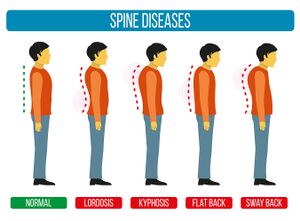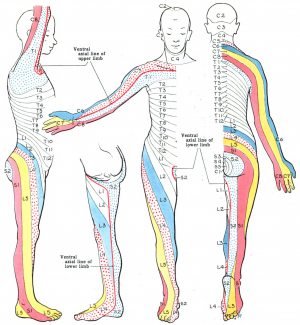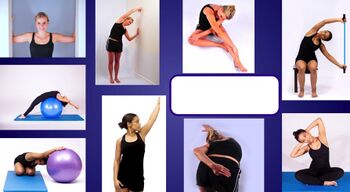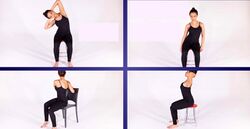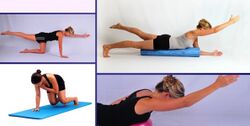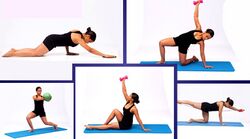Assessment and Treatment of the Thoracic Spine: Difference between revisions
No edit summary |
No edit summary |
||
| Line 10: | Line 10: | ||
* How has the pain progressed over time? | * How has the pain progressed over time? | ||
* Is there a history of overload or trauma? | * Is there a history of overload or trauma? | ||
* Does the patient have pain with breathing? And during which part of the breath does this occur? | * Does the patient have pain with breathing? And if so, during which part of the breath does this occur? | ||
* What effect does coughing and / or sneezing have? | * What effect does coughing and / or sneezing have? | ||
* Can the patient lie on the affected side at night? | * Can the patient lie on the affected side at night? | ||
* How is the pain behaving and what is the level of irritability? | * How is the pain behaving and what is the level of irritability? | ||
** If there is stiffness for a prolonged period in the morning? | |||
** If there is stiffness for a prolonged period in the morning | ** Is there also a history of enthesopathies? | ||
* What are the specific functional impairments? | ** This history could indicate that the patient has a seronegative [[Co-morbidities and Extra-articular Manifestations of Spondyloarthropathy|spondyloarthropathy]]<ref name=":0" /><ref>Martey C. Co-morbidities within Spondyloarthritis Course. Physioplus, 2020.</ref> | ||
* What are the patient's specific functional impairments? | |||
** Consider sport and activities of daily living | |||
* What is the patient’s medical history? | * What is the patient’s medical history? | ||
** | ** It is essential to have a detailed understanding of this history as there are a number of conditions that can [[Clinical Reasoning and Pathologies of the Thoracic Spine|masquerade]] as musculoskeletal thoracic pain | ||
* Are there any psychosocial factors contributing to the pain? | * Are there any psychosocial factors contributing to the pain? | ||
* Are there any [[An Introduction to Red Flags in Serious Pathology|red flags]]?<ref>Finucane LM, Downie A, Mercer C, Greenhalgh SM, Boissonnault WG, Pool-Goudzwaard AL et al. [https://www.jospt.org/doi/10.2519/jospt.2020.9971?url_ver=Z39.88-2003&rfr_id=ori:rid:crossref.org&rfr_dat=cr_pub%20%200pubmed International framework for red flags for potential serious spinal pathologies]. J Orthop Sports Phys Ther. 2020;50(7):350-72.</ref> | * Are there any [[An Introduction to Red Flags in Serious Pathology|red flags]]?<ref>Finucane LM, Downie A, Mercer C, Greenhalgh SM, Boissonnault WG, Pool-Goudzwaard AL et al. [https://www.jospt.org/doi/10.2519/jospt.2020.9971?url_ver=Z39.88-2003&rfr_id=ori:rid:crossref.org&rfr_dat=cr_pub%20%200pubmed International framework for red flags for potential serious spinal pathologies]. J Orthop Sports Phys Ther. 2020;50(7):350-72.</ref> | ||
Subjective information can give clues about the potential cause of pain (inflammatory, mechanical or non-mechanical):<ref name=":0" /> | |||
* Nerve root or facet pain may be described as lancinating / nauseating and it may radiate and follow angulation of rib | * Nerve root or facet pain may be described as lancinating / nauseating and it may radiate and follow angulation of rib | ||
| Line 39: | Line 40: | ||
* The best ‘special test’ is the one the patient demonstrates to you | * The best ‘special test’ is the one the patient demonstrates to you | ||
* Consider the diaphragm | * Consider the diaphragm | ||
=== Objective Testing === | === Objective Testing === | ||
| Line 49: | Line 48: | ||
** Watch how the patient moves / drifts / hinges | ** Watch how the patient moves / drifts / hinges | ||
** Consider different [[Postural Changes Affecting Voice Production|types of postural dysfunctions]]<ref>Czaprowski D, Stoliński Ł, Tyrakowski M, Kozinoga M, Kotwicki T. [https://www.ncbi.nlm.nih.gov/pmc/articles/PMC5836359/ Non-structural misalignments of body posture in the sagittal plane]. Scoliosis Spinal Disord. 2018;13:6. </ref>(see Figure 1) | ** Consider different [[Postural Changes Affecting Voice Production|types of postural dysfunctions]]<ref>Czaprowski D, Stoliński Ł, Tyrakowski M, Kozinoga M, Kotwicki T. [https://www.ncbi.nlm.nih.gov/pmc/articles/PMC5836359/ Non-structural misalignments of body posture in the sagittal plane]. Scoliosis Spinal Disord. 2018;13:6. </ref>(see Figure 1) | ||
** Is the postural change a primary problem | ** Is the postural change a primary or secondary problem (e.g. lumbopelvic dysfunction) | ||
* [[Assessment of Breathing Pattern Disorders|Breathing mechanics]] | * [[Assessment of Breathing Pattern Disorders|Breathing mechanics]] | ||
* [[File:Dermatomes Grant.png|thumb|Figure 2. Dermatomes. ]]ROM tests from neutral | * [[File:Dermatomes Grant.png|thumb|Figure 2. Dermatomes. ]]ROM tests from neutral | ||
| Line 75: | Line 74: | ||
* Assess the patient in sitting in order to isolate the thoracic spine (by blocking the lumbar spine) | * Assess the patient in sitting in order to isolate the thoracic spine (by blocking the lumbar spine) | ||
* Assess for asymmetry of movement and any segmental | * Assess for asymmetry of movement and any segmental restriction | ||
** Remember that motor control is also important in the thoracic region, not just stiffness | ** Remember that motor control is also important in the thoracic region, not just stiffness | ||
| Line 81: | Line 80: | ||
* Flexion: feel for anterior tilt of the ribs | * Flexion: feel for anterior tilt of the ribs | ||
* Extension: feel for posterior | * Extension: feel for posterior tilt of the ribs | ||
* NB extension is the most limited movement in the thoracic spine<ref>Wilke HJ, Herkommer A, Werner K, Liebsch C. [https://journals.plos.org/plosone/article?id=10.1371/journal.pone.0177823 In vitro analysis of the segmental flexibility of the thoracic spine]. PLoS One. 2017;12(5):e0177823. </ref> | * NB extension is the most limited movement in the thoracic spine<ref>Wilke HJ, Herkommer A, Werner K, Liebsch C. [https://journals.plos.org/plosone/article?id=10.1371/journal.pone.0177823 In vitro analysis of the segmental flexibility of the thoracic spine]. PLoS One. 2017;12(5):e0177823. </ref> | ||
| Line 93: | Line 92: | ||
Assess the patient from behind - it is only necessary to look from the front if you wish to specifically assess the ribs from this position. During thoracic side bend there is:<ref name=":0" /> | Assess the patient from behind - it is only necessary to look from the front if you wish to specifically assess the ribs from this position. During thoracic side bend there is:<ref name=":0" /> | ||
* Ipsilateral approximation of the ribs | |||
* Contralateral separation of the ribs | |||
* Contralateral rib translation | * Contralateral rib translation | ||
== Treatment == | == Treatment == | ||
| Line 104: | Line 102: | ||
=== Thoracic Manipulation === | === Thoracic Manipulation === | ||
It is still not known if / why thoracic manipulation works, but it has been found that thoracic manipulation can decrease pain, improve mobility and enhance a patient’s feeling of health.<ref>Takatalo J, Leinonen T, Rytkönen M, Häkkinen A, Ylinen J. The effect of thoracic spine manipulation on thoracic spine pain and mobility – Preliminary results of RCT. Manual Therapy. 2016;25:e161.</ref> | It is still not known if / why thoracic manipulation works, but it has been found that thoracic manipulation can decrease pain, improve mobility and enhance a patient’s feeling of health.<ref>Takatalo J, Leinonen T, Rytkönen M, Häkkinen A, Ylinen J. The effect of thoracic spine manipulation on thoracic spine pain and mobility – Preliminary results of RCT. Manual Therapy. 2016;25:e161.</ref> | ||
* There is no evidence that one manipulation is better than another | * There is, however, no evidence that one manipulation is better than another | ||
* There is no evidence that thoracic manipulation has a long-term effect, so if it is used, it should be in combination with specific rehabilitation | * There is no evidence that thoracic manipulation has a long-term effect, so if it is used, it should be in combination with specific rehabilitation | ||
* Joint position, direction, velocity and force are all variables that should be considered<ref name=":0" /> | * Joint position, direction, velocity and force are all variables that should be considered<ref name=":0" /> | ||
| Line 114: | Line 112: | ||
* Consider the centre of gravity | * Consider the centre of gravity | ||
* Look for areas of muscle spasm or hyperactivity | * Look for areas of muscle spasm or hyperactivity (e.g. of iliocostalis) | ||
=== Iliocostalis Release === | === Iliocostalis Release === | ||
| Line 120: | Line 118: | ||
=== Posterior-Anterior Glides === | === Posterior-Anterior Glides === | ||
Patients with inverted thoracic spines, rotated | Patients with inverted thoracic spines, rotated spines and / or increased kyphosis will likely find posterior-anterior (PA) glides of the spinous processes uncomfortable as they are highly nociceptive.<ref name=":0" /> | ||
For patients with increased kyphosis, a PA glide on the rib angle while performing an AP glide on the anterior shoulder / coracoid can be effective. A rotatory technique for patients with kyphosis can be effective.<ref name=":0" /> | Instead, it can be beneficial to perform a PA glide on the rib angle (which results in a mobilisation of 13 articulations for each thoracic ring). For individuals with inverted spines, this will create an anterior-posterior (AP) movement on the spinous process.<ref name=":0" /> For patients with increased kyphosis, a PA glide on the rib angle while performing an AP glide on the anterior shoulder / coracoid can be effective. A rotatory technique for patients with kyphosis can be effective.<ref name=":0" /> | ||
=== Exercise Therapy === | === Exercise Therapy === | ||
A survey of thoracic spine management trends in the UK found that exercise is used widely as a treatment modality despite limited supporting evidence.<ref>Heneghan NR, Gormley S, Hallam C, Rushton A. Management of thoracic spine pain and dysfunction: A survey of clinical practice in the UK. Musculoskelet Sci Pract. 2019;39:58-66. </ref> | A survey of thoracic spine management trends in the UK found that exercise is used widely as a treatment modality despite limited supporting evidence.<ref>Heneghan NR, Gormley S, Hallam C, Rushton A. Management of thoracic spine pain and dysfunction: A survey of clinical practice in the UK. Musculoskelet Sci Pract. 2019;39:58-66. </ref> Speed, starting positions, dosage and load progression have not been investigated, but exercises which aim to stretch, mobilise and stabilise the thoracic spine can be beneficial in clinical practice.<ref name=":0" /> | ||
==== Specific Exercises ==== | ==== Specific Exercises ==== | ||
| Line 145: | Line 139: | ||
File:Exercises to enhance thoracic rotation.jpg|thumb|Figure 7. Thoracic rotation exercises. </gallery> | File:Exercises to enhance thoracic rotation.jpg|thumb|Figure 7. Thoracic rotation exercises. </gallery> | ||
Exercises to stabilise the thoracic spine are shown in figures 8, 9 and 10. Initially it is beneficial to use closed kinetic chain exercises (Figures 8 and 9) before aiming to increase strength through range (Figure 10) | Exercises to stabilise the thoracic spine are shown in figures 8, 9 and 10. Initially it is beneficial to use closed kinetic chain exercises (Figures 8 and 9) before aiming to increase strength through range (Figure 10). | ||
<gallery widths="250px" heights="350px"> | <gallery widths="250px" heights="350px"> | ||
| Line 152: | Line 146: | ||
File:Thoracic motor control strengthening through range exercises.jpg|thumb|Figure 10. Thoracic motor control exercises - strengthening through range. </gallery> | File:Thoracic motor control strengthening through range exercises.jpg|thumb|Figure 10. Thoracic motor control exercises - strengthening through range. </gallery> | ||
== A Lot is | == A Lot is Unknown == | ||
* Most ‘research’ is anecdotal | * Most ‘research’ is anecdotal, or on social media, YouTube | ||
* Information from other spinal areas has been ‘tansferred’ to the thoracic spine, not recognising the unique differences of the thorax | * Information from other spinal areas has been ‘tansferred’ to the thoracic spine, not recognising the unique differences of the thorax | ||
* | * There are many deep thoracic muscles whose contribution to motor control in the thorax is unknown, such as semispinalis thoracic and rotatores | ||
* It is also not known what role the thoracic spine has in proprioception | * It is also not known what role the thoracic spine has in proprioception | ||
| Line 163: | Line 157: | ||
* Use anatomical knowledge and biomechanical insights to look at poor motion habits | * Use anatomical knowledge and biomechanical insights to look at poor motion habits | ||
* | * Do not focus on tiny faults | ||
Management:<ref name=":0" /> | Management:<ref name=":0" /> | ||
| Line 169: | Line 163: | ||
* It can be beneficial to use specific techniques to mobilise restricted areas, but this will not result in macro changes | * It can be beneficial to use specific techniques to mobilise restricted areas, but this will not result in macro changes | ||
* Postural adjustments can, however, be used to change systems and make macro changes | * Postural adjustments can, however, be used to change systems and make macro changes | ||
* Thoracic rotation is essential for movement, sports and performance | * Thoracic rotation is essential for movement, sports and performance | ||
** Utilise exercises that promote rotation mobility (optimal range of motion), stability (motor control) and strength | |||
* Exercise therapy should be used in conjunction with manual therapy to achieve an optimal outcome | * Exercise therapy should be used in conjunction with manual therapy to achieve an optimal outcome | ||
* Management should not just focus on thoracic stiffness - it is perhaps more important to address thoracic motor control and segmental stability | * Management should not just focus on thoracic stiffness - it is perhaps more important to address thoracic motor control and segmental stability | ||
Revision as of 11:03, 4 September 2021
Top Contributors - Jess Bell, Kim Jackson, Kirenga Bamurange Liliane, Tarina van der Stockt, Lucinda hampton, Olajumoke Ogunleye, Aminat Abolade and Merinda Rodseth
Subjective Assessment[edit | edit source]
Detailed information on the assessment of the thoracic spine is available here, but specific questions to consider in the subjective assessment include:[1]
- How did the problem begin? How long has it been a problem?
- How has the pain progressed over time?
- Is there a history of overload or trauma?
- Does the patient have pain with breathing? And if so, during which part of the breath does this occur?
- What effect does coughing and / or sneezing have?
- Can the patient lie on the affected side at night?
- How is the pain behaving and what is the level of irritability?
- If there is stiffness for a prolonged period in the morning?
- Is there also a history of enthesopathies?
- This history could indicate that the patient has a seronegative spondyloarthropathy[1][2]
- What are the patient's specific functional impairments?
- Consider sport and activities of daily living
- What is the patient’s medical history?
- It is essential to have a detailed understanding of this history as there are a number of conditions that can masquerade as musculoskeletal thoracic pain
- Are there any psychosocial factors contributing to the pain?
- Are there any red flags?[3]
Subjective information can give clues about the potential cause of pain (inflammatory, mechanical or non-mechanical):[1]
- Nerve root or facet pain may be described as lancinating / nauseating and it may radiate and follow angulation of rib
- Costochondritis tends to be described as a deep, boring, aching pain in the chest wall that may radiate (often posteriorly or to the neck)
- Rib fracture or intercostal strain is typically described as a sudden, sharp / piercing pain, which is then aggravated by laughing, sneezing, coughing, deep breaths or any type of straining manoeuvre
- When patients have immobility, they tend to report stiffness, restricted movement, or a sense of feeling ‘stuck’
Objective Assessment[edit | edit source]
The objective examination is guided by findings in the subjective interview. Remember:[1]
- It is essential to understand which structures are loaded during each test
- Keep tests to a minimum
- “Less is more” to avoid flaring up the patient
- Consider combinations of tests
- The best ‘special test’ is the one the patient demonstrates to you
- Consider the diaphragm
Objective Testing[edit | edit source]
The following tests should be included in an objective examination of the thoracic spine:[1]
- Static and dynamic postural assessment:
- Watch how the patient moves / drifts / hinges
- Consider different types of postural dysfunctions[4](see Figure 1)
- Is the postural change a primary or secondary problem (e.g. lumbopelvic dysfunction)
- Breathing mechanics
- ROM tests from neutral
- Look for intersegmental restrictions
- Assess from behind
- Inter-ring and articular palpation during motion
- Motor control and strength tests
- Sitting
- Puppy lie
- 4 point
- Neurodynamic tests
- Neurological
- Thoracic dermatome testing (see Figure 2)
- Palpation, including the clavicle and first rib
Active Thoracic Movement Tests[edit | edit source]
During the active movement tests:[1]
- Assess the patient in sitting in order to isolate the thoracic spine (by blocking the lumbar spine)
- Assess for asymmetry of movement and any segmental restriction
- Remember that motor control is also important in the thoracic region, not just stiffness
Thoracic Flexion and Extension[edit | edit source]
- Flexion: feel for anterior tilt of the ribs
- Extension: feel for posterior tilt of the ribs
- NB extension is the most limited movement in the thoracic spine[9]
Thoracic Rotation[edit | edit source]
Rotation is one of the most useful tests for the thoracic spine. During rotation movements, it is possible to identify:[1]
- Stiffness
- Sequencing issues
Thoracic Side Bend / Lateral Shift[edit | edit source]
Assess the patient from behind - it is only necessary to look from the front if you wish to specifically assess the ribs from this position. During thoracic side bend there is:[1]
- Ipsilateral approximation of the ribs
- Contralateral separation of the ribs
- Contralateral rib translation
Treatment[edit | edit source]
Sleep[edit | edit source]
Sleep is the most powerful antioxidant.[1] It is recognised that there is a bi-directional relationship between pain and sleep.[10]
Thoracic Manipulation[edit | edit source]
It is still not known if / why thoracic manipulation works, but it has been found that thoracic manipulation can decrease pain, improve mobility and enhance a patient’s feeling of health.[11]
- There is, however, no evidence that one manipulation is better than another
- There is no evidence that thoracic manipulation has a long-term effect, so if it is used, it should be in combination with specific rehabilitation
- Joint position, direction, velocity and force are all variables that should be considered[1]
Postural Correction and Motor Control[edit | edit source]
Correcting a patient’s posture can also have a positive impact on a patient’s pain.[1]
- Consider the centre of gravity
- Look for areas of muscle spasm or hyperactivity (e.g. of iliocostalis)
Iliocostalis Release[edit | edit source]
Iliocostalis is the most lateral of the erector spinae.[12] Patients with significant thoracic kyphosis and lumbar lordosis may have increased activity of iliocostalis. This muscle can be released under the 10th and 11th ribs.[1]
Posterior-Anterior Glides[edit | edit source]
Patients with inverted thoracic spines, rotated spines and / or increased kyphosis will likely find posterior-anterior (PA) glides of the spinous processes uncomfortable as they are highly nociceptive.[1]
Instead, it can be beneficial to perform a PA glide on the rib angle (which results in a mobilisation of 13 articulations for each thoracic ring). For individuals with inverted spines, this will create an anterior-posterior (AP) movement on the spinous process.[1] For patients with increased kyphosis, a PA glide on the rib angle while performing an AP glide on the anterior shoulder / coracoid can be effective. A rotatory technique for patients with kyphosis can be effective.[1]
Exercise Therapy[edit | edit source]
A survey of thoracic spine management trends in the UK found that exercise is used widely as a treatment modality despite limited supporting evidence.[13] Speed, starting positions, dosage and load progression have not been investigated, but exercises which aim to stretch, mobilise and stabilise the thoracic spine can be beneficial in clinical practice.[1]
Specific Exercises[edit | edit source]
Stretches for the thoracic spine are shown in Figure 3. Figure 4 shows stretches that can specifically address an inverted thoracic spine.
Figures 5 and 6 show exercises to mobilise the thoracic spine, while Figure 7 focuses specifically on rotation of the thoracic spine.
- Exercises to mobilise the thoracic spine.jpg
Figure 5. Exercises to mobilise the thoracic spine.
Exercises to stabilise the thoracic spine are shown in figures 8, 9 and 10. Initially it is beneficial to use closed kinetic chain exercises (Figures 8 and 9) before aiming to increase strength through range (Figure 10).
- Thoracic motor control strengthening through range exercises.jpg
Figure 10. Thoracic motor control exercises - strengthening through range.
A Lot is Unknown[edit | edit source]
- Most ‘research’ is anecdotal, or on social media, YouTube
- Information from other spinal areas has been ‘tansferred’ to the thoracic spine, not recognising the unique differences of the thorax
- There are many deep thoracic muscles whose contribution to motor control in the thorax is unknown, such as semispinalis thoracic and rotatores
- It is also not known what role the thoracic spine has in proprioception
Summary[edit | edit source]
Assessment:[1]
- Use anatomical knowledge and biomechanical insights to look at poor motion habits
- Do not focus on tiny faults
Management:[1]
- It can be beneficial to use specific techniques to mobilise restricted areas, but this will not result in macro changes
- Postural adjustments can, however, be used to change systems and make macro changes
- Thoracic rotation is essential for movement, sports and performance
- Utilise exercises that promote rotation mobility (optimal range of motion), stability (motor control) and strength
- Exercise therapy should be used in conjunction with manual therapy to achieve an optimal outcome
- Management should not just focus on thoracic stiffness - it is perhaps more important to address thoracic motor control and segmental stability
References[edit | edit source]
- ↑ 1.00 1.01 1.02 1.03 1.04 1.05 1.06 1.07 1.08 1.09 1.10 1.11 1.12 1.13 1.14 1.15 1.16 1.17 1.18 Bell-Jenje T. Assessment and Treatment of the Thoracic Spine Course. Physioplus, 2021.
- ↑ Martey C. Co-morbidities within Spondyloarthritis Course. Physioplus, 2020.
- ↑ Finucane LM, Downie A, Mercer C, Greenhalgh SM, Boissonnault WG, Pool-Goudzwaard AL et al. International framework for red flags for potential serious spinal pathologies. J Orthop Sports Phys Ther. 2020;50(7):350-72.
- ↑ Czaprowski D, Stoliński Ł, Tyrakowski M, Kozinoga M, Kotwicki T. Non-structural misalignments of body posture in the sagittal plane. Scoliosis Spinal Disord. 2018;13:6.
- ↑ Jones MR, Prabhakar A, Viswanath O, Urits I, Green JB, Kendrick JB et al. Thoracic outlet syndrome: a comprehensive review of pathophysiology, diagnosis, and treatment. Pain Ther. 2019;8(1):5-18.
- ↑ Li N, Dierks G, Vervaeke HE, Jumonville A, Kaye AD, Myrcik D et al. Thoracic outlet syndrome: a narrative review. J Clin Med. 2021;10(5):962.
- ↑ John Gibbons. Upper Limb Tension Test (ULTT) for the Median Nerve (C5-T1 Brachial plexus). Available from: https://www.youtube.com/watch?v=fhsrNKWVh0s [last accessed 4/9/2021]
- ↑ ohn Gibbons. Upper Limb Tension Test - Radial Nerve (C5-T1 Brachial Plexus). Available from: https://www.youtube.com/watch?v=VngRTMhAlGE [last accessed 4/9/2021]
- ↑ Wilke HJ, Herkommer A, Werner K, Liebsch C. In vitro analysis of the segmental flexibility of the thoracic spine. PLoS One. 2017;12(5):e0177823.
- ↑ Haack M, Simpson N, Sethna N, Kaur S, Mullington J. Sleep deficiency and chronic pain: potential underlying mechanisms and clinical implications. Neuropsychopharmacology. 2020;45(1):205-16.
- ↑ Takatalo J, Leinonen T, Rytkönen M, Häkkinen A, Ylinen J. The effect of thoracic spine manipulation on thoracic spine pain and mobility – Preliminary results of RCT. Manual Therapy. 2016;25:e161.
- ↑ Henson B, Kadiyala B, Edens MA. Anatomy, Back, Muscles. [Updated 2021 Aug 10]. In: StatPearls [Internet]. Treasure Island (FL): StatPearls Publishing; 2021 Jan-. Available from: https://www.ncbi.nlm.nih.gov/books/NBK537074/
- ↑ Heneghan NR, Gormley S, Hallam C, Rushton A. Management of thoracic spine pain and dysfunction: A survey of clinical practice in the UK. Musculoskelet Sci Pract. 2019;39:58-66.
